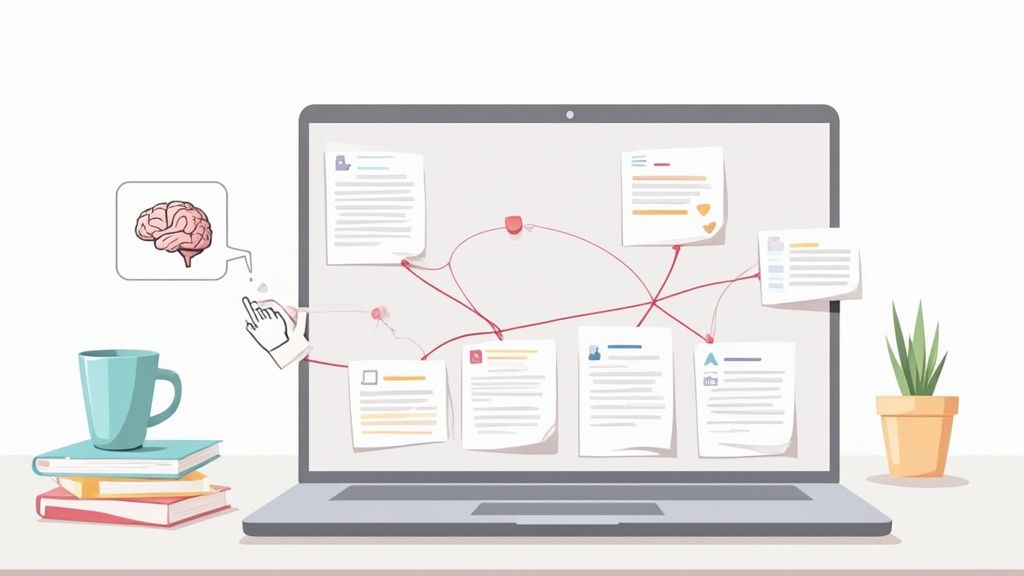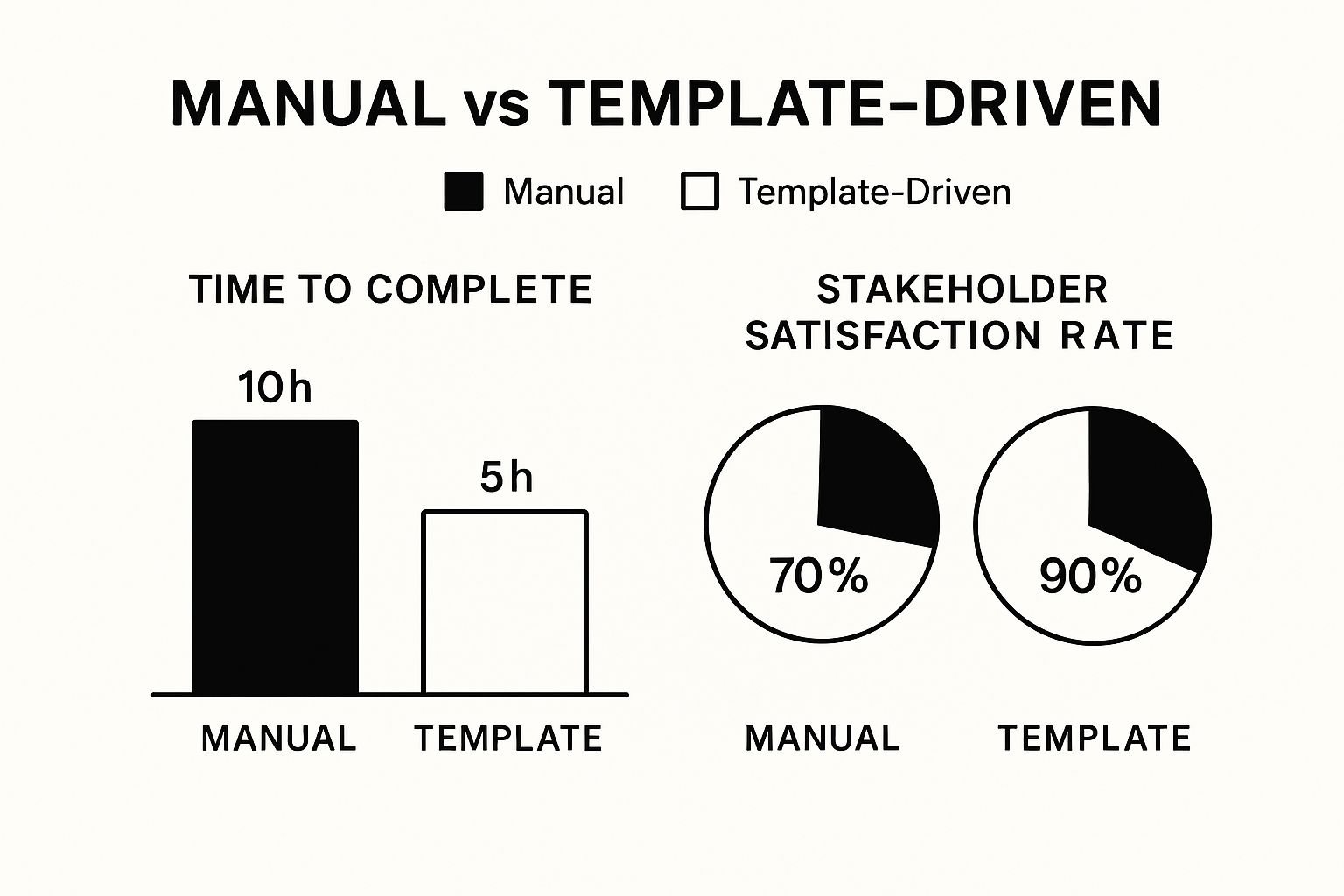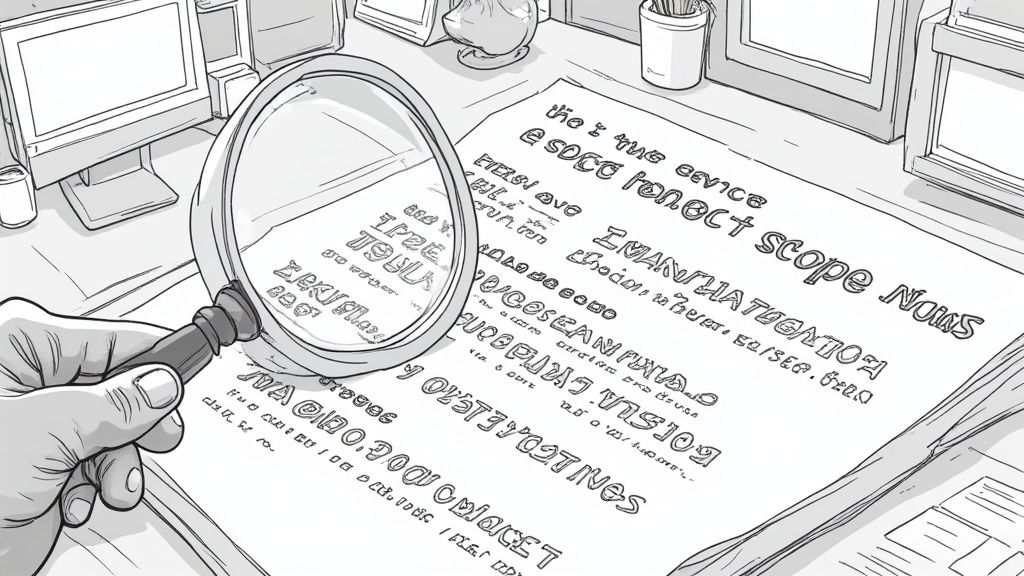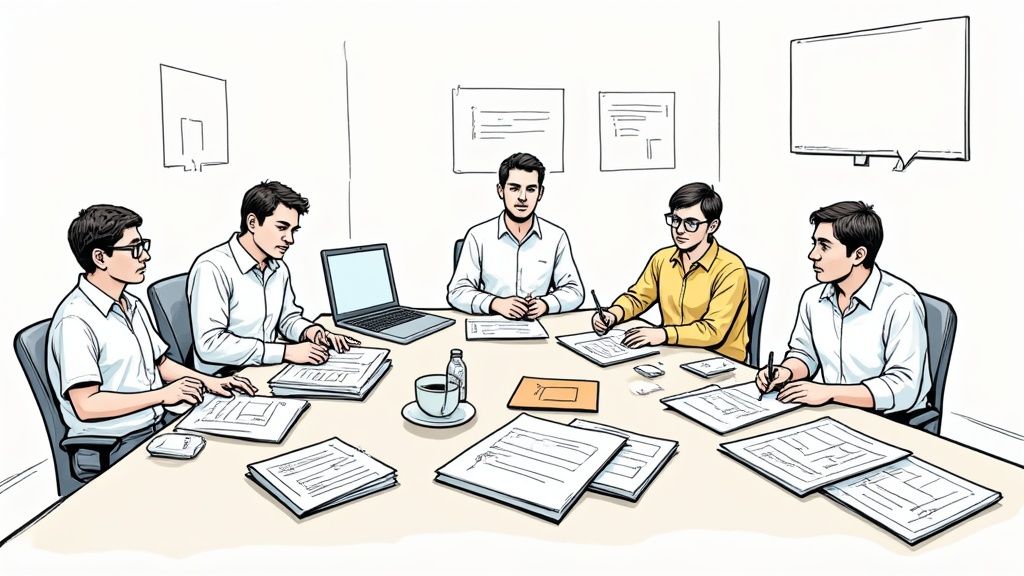Build a Dynamic Project Requirements Template

A project requirements template is supposed to be your single source of truth—a blueprint that outlines the goals, scope, and features of a project. It’s the document that gets everyone, from developers to business analysts, aligned on what to build and why.
But let's be honest, how often does that actually work out?
Why Static Templates No Longer Work
If you're still wrestling with project requirements in scattered Word documents or overly complex spreadsheets, you know the pain. These static files almost always become a source of confusion rather than clarity.
A simple change from a stakeholder can set off a chain reaction of updates. Before you know it, you're drowning in version control nightmares, and nobody is quite sure which file is the "final_final_v3.docx".
This chaos isn't just a minor annoyance; it's a real drain on the budget. In fact, studies show that nearly 10% of project expenditure is lost each year due to poor performance, and a lot of that comes right back to unclear or incomplete requirements. With over 85% of project managers juggling multiple projects at once, the need for a bulletproof system is more critical than ever.
You can learn more about how fuzzy requirements hit the bottom line in this 2025 project management statistics report.
The Shift to Dynamic Systems
So, what’s the alternative? A dynamic, intelligent system that lives and breathes with your project. Instead of a lifeless document you have to constantly police, imagine a central hub that naturally connects requirements to your meeting notes, stakeholder feedback, and even design mockups.
This is exactly where a networked tool like Obsidian, supercharged with Obsibrain, completely changes the game.
The data speaks for itself. Moving away from manual, static methods leads to major wins in both efficiency and team alignment.

It's not just about shaving hours off your week. It’s about building a better final product that truly delivers on what everyone agreed to.
A dynamic system offers a clear advantage over old-school static files. Here’s a quick comparison to see what that really means in practice.
Static vs Dynamic Requirements Management
Connectivity
Isolated; manual linking required.
Natively interconnected with notes, tasks, and meetings.
Version Control
Prone to errors (e.g., "v1", "v2_final").
A single, live version. History is tracked automatically.
Updates
Manual and time-consuming.
Real-time updates reflect across the entire system.
Accessibility
Stored in folders; can be hard to find.
Centralized and searchable, accessible from anywhere.
Intelligence
Passive; just a container for text.
Active; can parse notes and suggest requirements.
This table makes it pretty clear: while static templates were a good starting point, a dynamic approach is where modern project management is headed.
Obsibrain's Role in Modern Requirements
With a tool like Obsibrain, your project requirements template is no longer just a passive checklist. It becomes an active participant in your workflow.
A dynamic template provides a single source of truth that adapts to project changes in real-time. It eliminates ambiguity and ensures every team member is working from the most current information, which is the foundation of successful project delivery.
Think about it. You can feed raw, messy notes from a client call directly into Obsibrain and ask it to pull out the key requirements and format them for you. You could even use Obsibrain to draft a Statement of Work (SOW) based on those newly extracted requirements, bridging the gap between initial talks and formal project kickoff.
What used to be a tedious admin task is now a strategic advantage. This frees you up to focus on the important stuff—like analysis and planning—instead of getting bogged down in documentation. It effectively closes the gap between discussion and execution, which is where so many projects fall apart.
Building Your Template Foundation in Obsidian

If you're tired of project requirements living in scattered files, it's time to build a solid framework right inside Obsidian. This isn't just about creating a new note; it's about engineering a reusable foundation for all your projects. The idea is to have a core structure you can deploy instantly, bringing consistency from day one.
The easiest way to get started is with Obsidian’s built-in "Templates" core plugin. Once you enable it, just create a new note inside a dedicated templates folder. This note will become your master blueprint, ready to be customized.
Defining Your Core Sections
A great template needs clear, well-defined sections. Think of these headers as signposts that guide anyone on the project, making sure all the critical information gets captured.
From my experience, a solid starting point includes:
Project Overview: A quick, high-level summary. What’s the project for? What are its goals?
Key Stakeholders: Who's involved? List the key people and their roles.
Scope & Boundaries: Be crystal clear about what's in the project and, just as importantly, what's out. This prevents scope creep later.
Deliverables: A simple checklist of the tangible things the project will produce.
This structure is more than just an outline. A well-defined project requirements template is your first line of defense against misaligned expectations. It forces clarity on deliverables, tasks, and scope right from the jump. You can check out more on why structured templates are fundamental to project success on Smartsheet.com.
By setting up these foundational elements, you're not just creating a document. You're building a repeatable system that brings a sense of order to the often chaotic kick-off phase of a new project.
Making Your Template Dynamic
Now for the fun part: making your template active. This is where the real power of Obsidian comes into play.
By adding simple tags like #project/active or #client/XYZ, you can start grouping related documents automatically. Even better, you can embed queries to pull in other relevant notes, like meeting minutes or research that mentions the project’s unique ID.
This is also where you prime your notes for Obsibrain. When your template is structured this way, you're setting the stage for AI-driven insights. For example, you can use Obsibrain to scan all notes tagged with a specific client and generate a summary of their past requests and feedback, giving you invaluable context before a new project even begins.
To see how this all connects, take a look at Obsibrain's integrated task management capabilities. It gives you a good sense of how a smart template can evolve.
Once you have a solid foundation for your project requirements template, it's time for the fun part. Let's make it smart. This is where Obsibrain's AI features come into play, turning your structured notes from a simple document into an active, intelligent partner.
Think about this scenario: you just finished an hour-long stakeholder interview. Instead of the tedious task of re-listening and typing out every key point, you can just feed the raw transcript to Obsibrain. A simple prompt is all it takes to get a concise, bulleted list of requirements. That's a huge time-saver right there.
From Automation to Analysis
But this is about more than just summarizing text; it’s about active analysis. Obsibrain can take new information and instantly cross-reference it with the existing requirements you've already documented in your note. This lets you ask sharp, targeted questions to uncover hidden problems before they blow up.
For instance, you could ask Obsibrain something specific like:
"Based on the functional requirements and stakeholder feedback documented here, identify three potential risks or scope conflicts."
The AI will then scan the text to pinpoint contradictions or unclear points, like when two different departments ask for features that clash with each other. This kind of proactive risk identification is a massive advantage, effectively turning your template into an early warning system.
Another powerful use is generating detailed specifications from high-level goals. Let's say your "Project Overview" section includes a goal like "increase user engagement by 15%." You can then prompt Obsibrain to brainstorm user stories or technical specs that would help you hit that target.
Generate User Stories: Ask, "Create three user stories for a mobile app feature that would help increase daily user engagement."
Draft Technical Specs: Prompt it with, "Outline the key technical considerations for implementing a new user notification system."
Uncovering Deeper Insights
This isn't just about making documentation faster. It's about using AI to accelerate the entire requirements-gathering process by revealing insights you might have otherwise missed. A great use case is competitive analysis: you can feed Obsibrain links to competitor product pages and ask it to extract key features, which can then be compared against your own project requirements. If you want to get a better sense of what's possible, exploring the best AI tools for project management can give you some great ideas for your own dynamic template.
The real power of bringing Obsibrain into your workflow is this collaborative loop. You provide the structured context with your template, and the AI provides the analytical horsepower to connect the dots, spark ideas, and flag potential issues. This synergy elevates your project requirements template from a static container for information to a dynamic participant in your project's success.
Managing Data-Intensive Requirements

Many projects today are drowning in data, especially in fields like tech and analytics. A simple to-do list just doesn't cut it anymore. Your project requirements template needs to be built to handle this complexity, capturing the nitty-gritty of how data will be managed.
This means your Obsidian template has to evolve. You need dedicated sections for the critical data-related details that can make or break a project. I've seen firsthand how projects go sideways because of bad data, and a solid template is your first line of defense. Specifying things like data categories, sources, and metadata from the start helps you avoid the headache of erroneous data later, keeping both quality and compliance in check.
Structuring for Data and AI
One of the biggest wins of a well-structured, data-centric template is that it helps you strategically plan how to avoid scope creep. When the data requirements are fuzzy, the project scope is bound to expand. Your template is the place to nail this down.
Think about adding these sections to your Obsidian note:
Data Sources: Where is the data coming from? Get specific—list the APIs, databases, or even the exact flat files.
Validation Rules: What does "good" data even look like for this project? Define the constraints, required formats, and quality checks here.
Privacy & Compliance: Is there any GDPR, CCPA, or other regulatory stuff to worry about? Note it down. Don't let this be an afterthought.
Transformation Logic: How will the raw data be cleaned, merged, or otherwise manipulated before it's useful?
With this structure in place, your template becomes a powerful context for Obsibrain. Instead of just listing requirements, you can now interact with them intelligently.
This setup flips your document from being a static record into an active partner in your analysis. You can start asking Obsibrain questions like, "Based on these data requirements, what are potential integration challenges?" or "Generate a checklist for ensuring data quality based on our defined rules." This is especially useful for creating UAT (User Acceptance Testing) scripts, as Obsibrain can draft test cases directly from your validation rules.
This approach also plugs perfectly into Obsibrain's features for structured daily planning, making sure these crucial data considerations are a part of your everyday workflow, not just a one-off document.
Bringing Your Dynamic Template to Life
A template is just a blueprint until you actually use it. So, let's walk through a real-world scenario to see how this dynamic system really shines. We'll use a hypothetical project: building a new customer feedback portal for a software company.
First things first, you kick off the project by creating a new note from your master project requirements template. This single click instantly scaffolds your new note with all the sections you built earlier—Project Overview, Stakeholders, Scope, and Deliverables. You can then fill in the high-level details you already know, establishing a solid foundation from the get-go.
From Meetings to Actionable Insights
Now, picture this: you're in the kickoff meeting with the product and support teams, taking notes in a separate Obsidian file. Instead of spending time later copying, pasting, and reformatting, you just link that meeting note directly to your main project document.
This is where the magic really happens. You prompt Obsibrain:
"Review the linked meeting notes and extract all functional requirements for the customer feedback portal. List them as bullet points under the 'Functional Requirements' section."
Obsibrain doesn't just do a simple copy-paste. It actually understands the context, intelligently identifying, synthesizing, and formatting the key requirements discussed during the meeting. It turns a messy, conversational brain dump into a clean, structured list. This one step can genuinely save you hours of tedious admin work.
Creating a Live Project Dashboard
With your requirements neatly documented, the next step is to make them trackable. This is surprisingly easy. You can add a simple status property to each requirement using Obsidian's frontmatter or even just a tag system.
status: to-dostatus: in-progressstatus: under-reviewstatus: complete
Just by adding these simple properties, you've transformed your static document into a living, breathing dashboard. At any moment, you can get a quick, at-a-glance overview of your project's progress. You could even ask Obsibrain something like, "Show me all requirements with the status 'to-do' and summarize the top three priorities based on the project goals."
Seeing this workflow in action really highlights the practical benefits of a system that actively helps you manage your project, not just document it. To get a better feel for the concepts behind this, it’s worth exploring the broader ideas of dynamic document generation, as it shows how powerful these automated systems can be.
Frequently Asked Questions

As you start weaving Obsibrain into your workflow, some common questions naturally come up. Let's get those answered so you can start building your project requirements template with confidence.
Can This Work for Non-Technical Projects?
Absolutely. Don't let the talk of software projects fool you. The core ideas of defining scope, stakeholders, and deliverables are universal. A marketing campaign, a new book, or an event plan needs just as much clarity.
For example, a marketing manager could use Obsibrain to analyze competitor ad copy and generate new headline ideas. An author could use it to check for plot inconsistencies across chapter summaries. It’s flexible enough for any field.
How Does Obsibrain Handle Data Privacy?
This is a big one, and rightly so. Obsibrain was built with a "privacy-first" mindset. It runs entirely on your local machine, interacting with your Obsidian vault without ever phoning home or sending your sensitive project notes to the cloud.
Your requirements, stakeholder information, and any proprietary details stay completely confidential and under your control. It's your data, period.
How to Share Requirements with Others?
What if your team isn't on the Obsidian train yet? No worries. While all the intelligent magic happens inside your vault, you can easily export clean, formatted reports for anyone.
Just use Obsidian's built-in export-to-PDF feature, or simply copy the clean Markdown into an email or a Google Doc. You can even ask Obsibrain to generate a concise executive summary from your detailed requirements note, perfect for sharing with leadership. The real power is having a smart, dynamic system for yourself, even if the final output is shared in a more traditional format. For a bit more context on how this works, check out this guide on what a template is in the context of Obsibrain.
Can Obsibrain Help Prioritize Requirements?
Yes, and this is where things get really interesting. Once you’ve documented all your requirements, you can actually ask Obsibrain to analyze them against your stated project goals. It's like having a strategic partner built right in.
For instance, you could prompt it with something like: "Given our goal of launching an MVP in three months, rank these requirements by priority and flag any that could be pushed to a later phase." This simple query instantly turns your static list into a powerful decision-making tool.
Ready to stop switching between apps and start building a truly intelligent workflow? With Obsibrain, you can centralize your tasks, notes, and project requirements into a single, powerful system inside Obsidian. Get your one-time purchase today and unlock lifetime updates. Learn more and get Obsibrain now.
Last updated
Was this helpful?